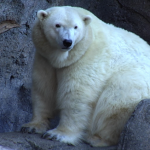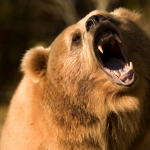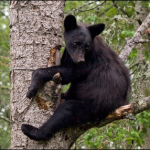Genus Ursus: The 4 Giant Bears
The family Ursidae contains the genus Ursus, which includes 4 species of bear, the brown bears, the polar bear and the two species of black bear. Our video highlights the three that can be found in North America (the American Black Bear, brown bear, and polar bear). All three can be found in the Yukon Delta National Wildlife Refuge.
These are the living species in the genus Ursus:
- American Black Bear: (Ursus americanus)
- Brown Bear: (Ursus arctos)
- Polar Bear: (Ursus maritimus)
- Asiatic Black Bear: (Ursus thibetanus)
Comparing Bears
Three native bear species inhabit North America; the American black bear, the polar bear, and the brown bear. Each exhibit characteristic differences. Black bears are expert tree-climbers, polar bears are exceptional swimmers, and grizzly bears are champion diggers. Most people are familiar with the brown bear subspecies, the grizzly bear (Ursus arctos horribilis). Grizzly bears can climb trees, although their skills are limited. Polar bears and grizzly bears are the most aggressive species towards humans.
The black bear is the most abundant and widespread. All three North American bear species are large mammals with strong jaws, heavy paws and claws, large noses, small eyes and ears, and short tails. They have developed an exceptional sense of smell to help locate food. They also have good hearing. Although untested, scientists believe bears and humans have similar visual capabilities. All three bear species can run faster than 30 miles per hour, although they quickly overheat due to their massive size.
POLAR BEAR
The largest in size – but fewest in numbers – polar bears inhabit the northern Arctic regions. In some areas, their range overlaps with grizzly bear and black bear ranges. Polar bears most likely evolved from brown bears. Although rare, grizzly bears and polar bears can breed and produce fertile offspring.
largest in size – but fewest in numbers – polar bears inhabit the northern Arctic regions. In some areas, their range overlaps with grizzly bear and black bear ranges. Polar bears most likely evolved from brown bears. Although rare, grizzly bears and polar bears can breed and produce fertile offspring.
GRIZZLY BEAR
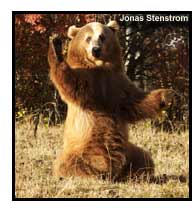
Some grizzly bears are the size of big black bears, while others may be as large as medium-sized polar bears. Because of their salmon-rich diet, coastal grizzly bears (also referred to as brown bears) grow larger than their inland counterparts and can easily weigh over 1000 pounds. Grizzly bear fur ranges in color from buff to dark brown. Coats are often white-tipped, especially on the back, resulting in a frosted, or grizzled, appearance.
AMERICAN BLACK BEAR
The American black bear is the most widespread of the three North American bear species. Historically, black bears ranged from the Atlantic to the Pacific, from northern Mexico to the Arctic Circle. Today, the black bear is the only bear species living east of the Mississippi River.
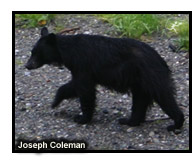
Black bears are often black in color with tan muzzles; occasionally they sport white markings on their chests. However, their coats can range from blonde to deep brown to blue-gray to white. Black-colored bears are more common in the East while brown-colored bears are more common in the West. Although rare, white and bluish-colored bears can occur in the Pacific Northwest.
Black bears are the smallest North American bear species. Across their range, adults vary greatly in size, shape, and color because of habitat differences, genetics, and food abundance. Black bears exhibit dramatic seasonal changes in their weight. In late summer and fall, black bears prepare for winter hibernation by consuming huge quantities of food. An adult that weighs 200 pounds in spring can weigh 300 pounds in the fall after months of gorging on fruits and nuts. During the winter, males and females den in tree cavities, excavated underground holes, or even above ground nests.
ASIATIC BLACK BEAR
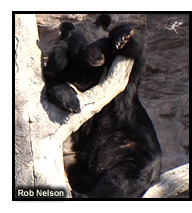
In contrast to polar bears, Asian black bears have powerful upper bodies for climbing trees, and relatively weak hind legs, which are shorter than in brown bears and American black bears. A black bear with broken hind legs can still climb effectively. They are the most bipedal of all bears, and have been known to walk upright for over a quarter mile. The heel pads on the forefeet are larger than those of most other bear species. Their claws, which are primarily used for climbing and digging, are slightly longer on fore foot (30–45 mm) than back (18–36 mm), and are larger and more hooked than those of the American black bear. The ears are bell shaped, and are proportionately longer than those of large bears, and stick out sideways from the head. The lips and nose are larger and more mobile than those of brown bears.

